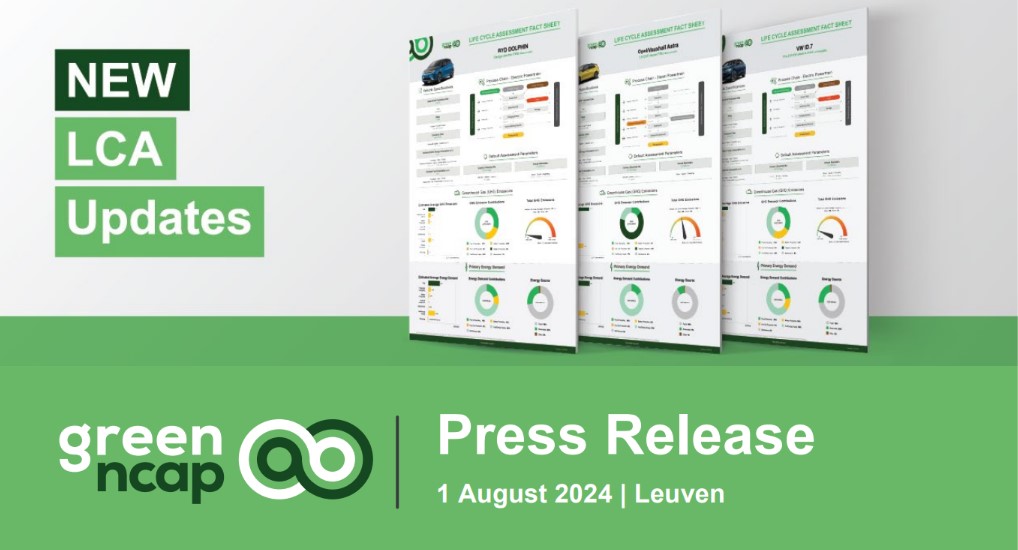
Green NCAP has recently implemented an update of its Life Cycle Assessment (LCA) data and fact sheets. The update includes increased data coverage of countries, including Norway, and fuel types, such as LPG and E85, as well as more up to date information on battery production, supply of electricity and biofuel mixes. This update reflects the evolving automotive industry and the rapidly changing energy sector. More than ever, Green NCAP’s LCA creates a bridge for knowledge between science, industry and consumers.
Through this recent data update, Green NCAP can reveal changes happening in industry. From the evolving raw materials blends for biofuels to the increasing efficiency of battery production, our experts have observed a steady positive change in the sustainable picture of industry. It can be said that the ever-increasing scope of our LCA data is a direct response to the growth and innovation currently taking place in the automotive sector. Green NCAP’s new LCA results have revealed the lowered environmental impacts of electric and plug-in hybrid vehicles over their lifetime, compared to conventional combustion engine vehicles. This change can be attributed primarily to the decreasing carbon intensity of battery production and the improving expectations for Europe’s future energy mix.
Emissions from battery production, in kg CO2-eq./kWh capacity, have decreased by ca. 16 percent in the new data, driven primarily by economies of scale and sustainability efforts of manufacturers. On average in Europe, electricity emission projections between today and 2039, in grams CO2-eq./kWh, are expected to decrease by about 26 percent compared to old data. Increasingly ambitious policy initiatives, such as Fit for 55, are the driving force behind heightened expectations for greener European energy. Overall, these improvements in the industry, now reflected in the data, have resulted in a decrease in emissions of 20 grams CO2-eq./km for the average battery electric vehicle. Biomass mix of biofuels is also changing. Most notably, FAME fuel (Biodiesel) is expected to contain 13 percentage points more used cooking oil and 16 percentage points less palm oil by 2050, which lowers the lifetime emissions of this fuel.
LCA is a methodology that estimates all the emissions associated with the production and use of a specific product from cradle to grave. There is a broad consensus that this method is essential for producing fair environmental assessments of transportation systems. LCA calculations therefore allow us to compare vehicles in a more neutral and systematic manner. Additionally, Green NCAP’s LCA produces results and fact sheets that are especially catered to what consumers are driving today. Green NCAP’s updated data better reflects the energy supply and batteries currently on the market and can deliver more realistic results as it uses Green NCAP’s actual test consumption measurement data. With this update, Green NCAP’s LCA has been praised for its reliability and validity, setting itself apart from other LCAs available on the market.
Ricardo, the UK-based global consultancy, which focuses on environmental and engineering issues, assisted Green NCAP in providing data projections for electricity supply in European countries. Their projections are widely regarded as high quality and transparent energy mix data. This was a huge contribution to the overall LCA data update.
Ricardo and Green NCAP have a long collaborative relationship. We appreciate Green NCAP’s approach to LCA with a focus on providing authentic data and customer usability. It is important that LCA data evolve to remain relevant and in step with industry, so we strongly support this update. We look forward to seeing its results. — Marco Raugei, Ricardo Senior Transport LCA Expert.
We are looking into the future, and nobody knows how electricity will be generated in 5 or 10 years. So, we need a kind of scenario for all the European countries with the same assumptions. That was one of the key reasons we took the data from Ricardo. They have a very consistent scenario for each of the 27 European countries based on technical feasibility and political expectations. Their numbers are extrapolated under two existing scenarios: Baseline (REF2020) and Tech1.5 (MIX scenario from Fit-for-55 package). What is crucial is to be as transparent as possible, by showing the tables and data we use. This has, from the very beginning, been a guiding principle in this project. LCA can bridge knowledge from science to the broader public. Car manufacturers are increasingly publishing their very own LCAs, given they understand their vehicles and supply chains the best. But they still lack transparency in the data and methods used, making comparability between vehicles impossible. This is what Green NCAP’s LCA offers. — Dr. Gerfried Jungmeier, JOANNEUM RESEARCH leading scientist on the LCA tool project for Green NCAP.
The LCA of vehicles has been an essential part of the information Green NCAP offers. However, continual data updates are necessary to stay aligned with industry developments and changing energy supply trajectories. Green NCAP’s LCA, we believe, provides improved standardization, more realistic and relevant results, consumer-operability, and good comparison abilities. — Dr. Aleksandar Damyanov, Green NCAP Technical Manager.
You can find the 2024 fact sheets here.
For full results, visit www.greenncap.com.
For media information, please contact media@greenncap.com.